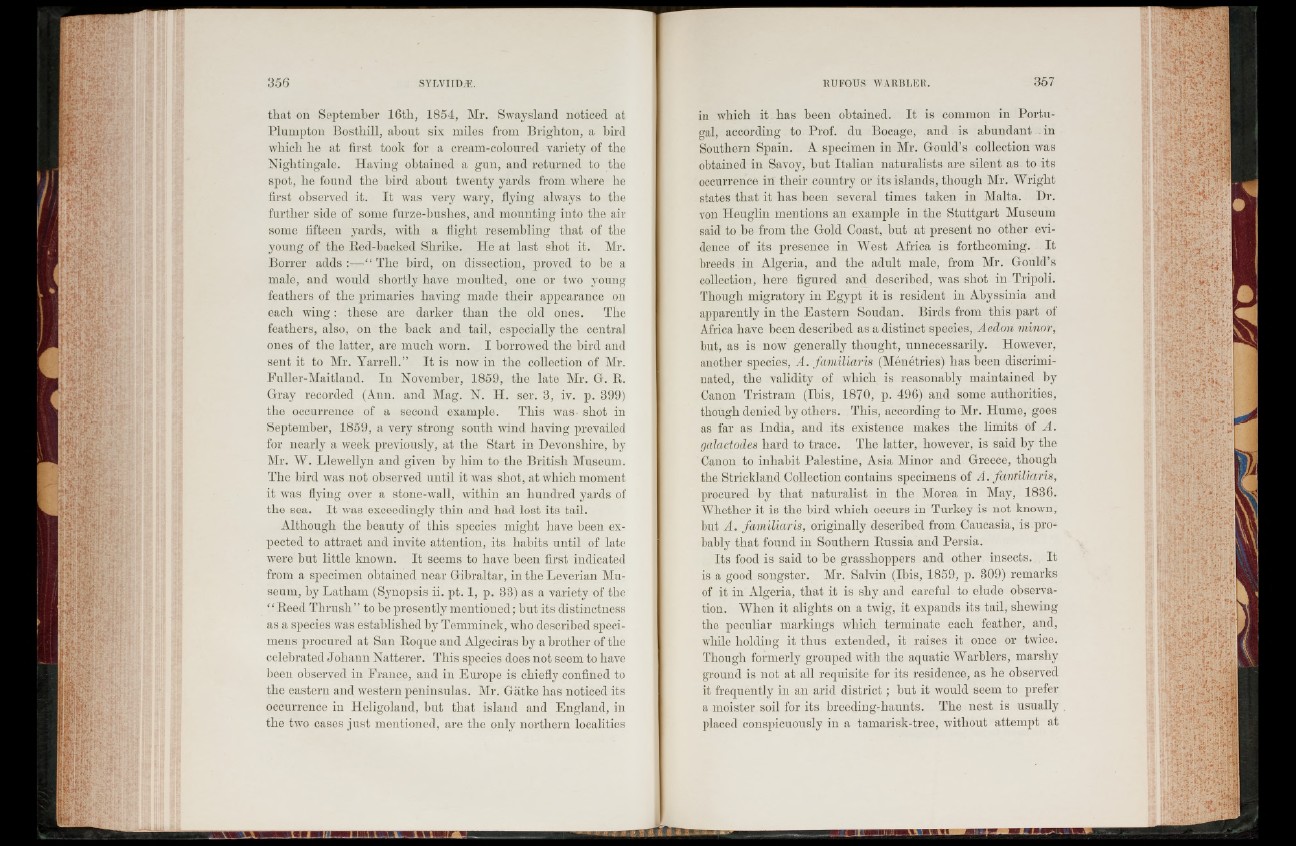
that on September 16th, 1854, Mr. Swaysland noticed at
Plumpton Bosthill, about six miles from Brighton, a bird
which lie at first took for a cream-coloured variety of the
Nightingale. Having obtained a gun, and returned to the
spot, he found the bird about twenty yards from where he
first observed it. I t was very wary, flying always to the
further side of some furze-bushes, and mounting into the air
some fifteen yards, with a flight resembling that of the
young of the Red-backed Shrike. He at last sliot it. Air.
Borrer adds :—“ The bird, on dissection, proved to be a
male, and would shortly have moulted, one or two young
feathers of the primaries having made their appearance on
each wing: these are darker than the old ones. The
feathers, also, on the back and tail, especially the central
ones of the latter, are much worn. I borrowed the bird and
sent it to Air. Yarrell.” I t is now in the collection of Mr.
Fuller-Alaitland. In November, 1859, the late Air. G. R.
Gray recorded (Ann. and Alag. N. H. ser. 8, iv. p. 399)
the occurrence of a second example. This was shot in
September, 1859, a very strong south wind having prevailed
for nearly a week previously, at the Start in Devonshire, by
Mr. W. Llewellyn and given by him to the British Museum.
The bird was not observed until it was shot, at which moment
it was flying over a stone-wall, within an hundred yards of
the sea. It was exceedingly thin and had lost its tail.
Although the beauty of this species might have been expected
to attract and invite attention, its habits until of late
were but little known. I t seems to have been first indicated
from a specimen obtained near Gibraltar, in the Leverian Museum,
by Latham (Synopsis ii. pt. 1, p. 33) as a variety of the
“ Reed Thrush” to be presently mentioned; but its distinctness
as a species was established by Temminck, who described specimens
procured at San Roque and Algeciras by a brother of the
celebrated Johann Natterer. This species does not seem to have
been observed in France, and in Europe is chiefly confined to
the eastern and western peninsulas. Air. Gatke has noticed its
occurrence in Heligoland, but that island and England, in
the two cases just mentioned, are the only northern localities
in which it has been obtained. It is common in Portugal,
according to Prof. du Bocage, and is abundant in
Southern Spain. A specimen in Air. Gould’s collection was
obtained in Savoy, but Italian naturalists are silent as to its
occurrence in their country or its islands, though Mr. Wright
states that it has been several times taken in Alalta. Dr.
von Heuglin mentions an example in the Stuttgart Museum
said to be from the Gold Coast, but at present no other evidence
of its presence in West Africa is forthcoming. It
breeds in Algeria, and the adult male, from Air. Gould’s
collection, here figured and described, was shot in Tripoli.
Though migratory in Egypt it is resident in Abyssinia and
apparently in the Eastern Soudan. Birds from this part of
Africa have been described as a distinct species, Aedon minor,
but, as is now generally thought, unnecessarily. However,
another species, A. familiaris (Menetries) has been discriminated,
the validity of which is reasonably maintained by
Canon Tristram (Ibis, 1870, p. 496) and some authorities,
though denied by others. This, according to Mr. Hume, goes
as far as India, and its existence makes the limits of A.
galactodes hard to trace. The latter, however, is said by the
Canon to inhabit Palestine, Asia Minor and Greece, though
the Strickland Collection contains specimens of A . fantiliaris,
procured by that naturalist in the Morea in May, 1836.
Whether it is the bird which occurs in Turkey is not known,
but A. familiaris, originally described from Caucasia, is probably
that found in Southern Russia and Persia.
Its food is said to be grasshoppers and other insects. It
is a good songster. Mr. Salvin (Ibis, 1859, p. 309) remarks
of it in Algeria, that it is shy and careful to elude observation.
AVhen it alights on a twig, it expands its tail, shewing
the peculiar markings which terminate each feather, and,
while holding it thus extended, it raises it once or twice.
Though formerly grouped with the aquatic Warblers, marshy
ground is not at all requisite for its residence, as he observed
it frequently in an arid distric t; but it would seem to prefer
a moister soil for its breeding-haunts. The nest is usually
placed conspicuously in a tamarisk-tree, without attempt at